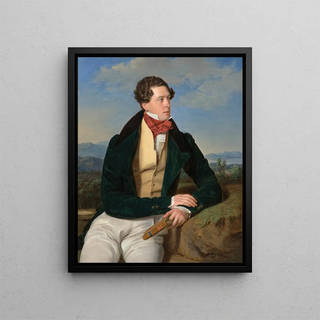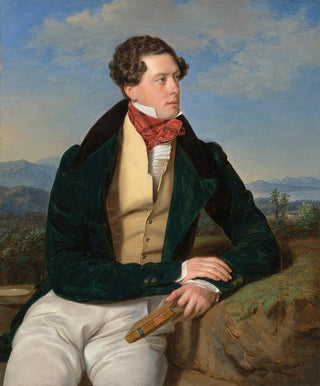Art print | L'acteur Maximilian Korn dans un paysage - Ferdinand Georg Waldmüller


View from behind

Frame (optional)
Ferdinand Georg Waldmüller’s artwork "L'acteur Maximilian Korn dans un paysage" immerses us in a universe where nature and humanity meet with unparalleled grace. This art print, capturing the fleeting moment of an actor deep in thought, evokes an atmosphere that is both peaceful and vibrant. Waldmüller, a master of realism, manages to seize the very essence of his model while placing him within a lush natural setting. This piece does more than depict a character; it tells a story, that of a man in harmony with his environment, while highlighting the beauty of 19th-century Austrian landscapes.
Style and uniqueness of the art print
Ferdinand Georg Waldmüller’s style is distinguished by its precision and attention to detail. In "L'acteur Maximilian Korn dans un paysage," every brushstroke appears to be carefully considered to pay homage to the beauty of the subject and his surroundings. The colors, both vivid and nuanced, create a warm atmosphere, while light plays a crucial role in the composition. The artist uses delicate shadows to give depth to Korn’s figure, emphasizing his contemplative expression. The way the landscape envelops the actor demonstrates a harmonious fusion between man and nature, an essential characteristic of Waldmüller’s work. This art print, both intimate and grandiose, invites viewers to reflect on the place of the individual in the vast world around them.
The artist and his influence
Ferdinand Georg Waldmüller, born in 1793 in Vienna, is an emblematic figure of the realist movement in painting. His work is marked by a quest for truth and authenticity, aiming to depict everyday life with particular sensitivity. Influenced by the social and political changes of his time, Waldmüller was able to capture the essence of Austrian life through his portraits and landscapes. His innovative approach paved the way for many artists who followed, and his legacy endures in contemporary art. By highlighting ordinary subjects, he redefined the aesthetic standards of his era.

Matte finish

View from behind

Frame (optional)
Ferdinand Georg Waldmüller’s artwork "L'acteur Maximilian Korn dans un paysage" immerses us in a universe where nature and humanity meet with unparalleled grace. This art print, capturing the fleeting moment of an actor deep in thought, evokes an atmosphere that is both peaceful and vibrant. Waldmüller, a master of realism, manages to seize the very essence of his model while placing him within a lush natural setting. This piece does more than depict a character; it tells a story, that of a man in harmony with his environment, while highlighting the beauty of 19th-century Austrian landscapes.
Style and uniqueness of the art print
Ferdinand Georg Waldmüller’s style is distinguished by its precision and attention to detail. In "L'acteur Maximilian Korn dans un paysage," every brushstroke appears to be carefully considered to pay homage to the beauty of the subject and his surroundings. The colors, both vivid and nuanced, create a warm atmosphere, while light plays a crucial role in the composition. The artist uses delicate shadows to give depth to Korn’s figure, emphasizing his contemplative expression. The way the landscape envelops the actor demonstrates a harmonious fusion between man and nature, an essential characteristic of Waldmüller’s work. This art print, both intimate and grandiose, invites viewers to reflect on the place of the individual in the vast world around them.
The artist and his influence
Ferdinand Georg Waldmüller, born in 1793 in Vienna, is an emblematic figure of the realist movement in painting. His work is marked by a quest for truth and authenticity, aiming to depict everyday life with particular sensitivity. Influenced by the social and political changes of his time, Waldmüller was able to capture the essence of Austrian life through his portraits and landscapes. His innovative approach paved the way for many artists who followed, and his legacy endures in contemporary art. By highlighting ordinary subjects, he redefined the aesthetic standards of his era.






